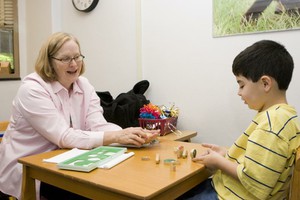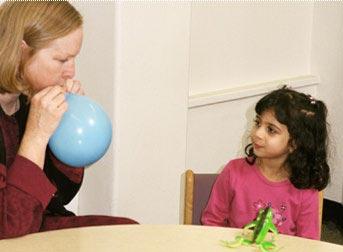THIS ARTICLE IS MORE THAN FIVE YEARS OLD
This article is more than five years old. Autism research — and science in general — is constantly evolving, so older articles may contain information or theories that have been reevaluated since their original publication date.

Special skill: Colleagues say Cathy Lord has an instant rapport with children on the autism spectrum.
In the late 1960s, as an undergraduate student in psychology at the University of California, Los Angeles, Cathy Lord spent a couple of hours a day teaching two young boys with autism.
She was working for clinical psychologist Ole Ivar Lovaas, one of a few doctors who believed in behavioral therapy for autism. Lovaas had plucked the boys out of a state hospital for his unconventional treatment, which focused on positive reinforcement ― from M&Ms to animated clapping ― of good behaviors.
One of the two boys Lord worked with improved tremendously. “He had been a little terror,” Lord recalls, and had been institutionalized for years. But after a few months of intense therapy, his disruptive behaviors stopped.
The approach didn’t work so well with the second boy, however, who had severe intellectual disability as well as autism. “I was supposed to teach him to talk, but he didn’t understand anything about what I was trying to do,” Lord says. She was happy just to be able to teach him to wash his hands and press an elevator button.
Lord came away from that experience with two lessons: that children with autism are better off outside mental institutions, and that behavioral therapy is inadequate. She went to graduate school, she says, “to figure out what else you can do for them.”
Since then, Lord has acquired a reputation for rigorous study of the autism phenotype. She’s worked with thousands of children in nine schools and clinics in the United States, Canada, and England. She and her colleagues have developed the field’s gold standard for autism diagnoses and in 2001, she launched the University of Michigan Autism & Communication Disorders Center (UMACC).
“She’s probably the smartest person I’ve ever worked with,” says long-time colleague Pam DiLavore, assistant director of the Treatment and Education of Autistic and Related Communication-Handicapped Children (TEACCH) Center in Raleigh. “[Lord] is one of the few psychologists I know who can go into an evaluation room with someone of any age, on any part of the autism spectrum, and develop an immediate rapport,” DiLavore says.
Lord has also developed solid relationships with her colleagues, staff and students. Although she’s perpetually juggling a dozen projects, they say, she still makes time for her graduate students and for her family.
“She got me involved in writing a couple of papers at a very early stage,” recalls John McLennan, who was a medical student when he met Lord at the University of Alberta in the late 1980s. “Her standards are very, very high. But she pushed people in a positive way, and always looked for opportunities to promote her students,” he says.
Early experiences:
Lord began her doctorate studies in psychology and social relations in 1971 at Harvard University. Three years later, when her husband took a job at Dartmouth, she finished her dissertation there and worked part-time at a school for children with disabilities.
None of the eight children, who ranged in age from 2 to 8 years, had been in a school before. On the first day of class, the scheduled teacher didn’t show up. Lord took over for the day, and then for the rest of the year, while the school tried to find a replacement. “It was horrifying,” she recalls. “I had no idea what I was doing.”
One girl was so developmentally delayed that she could not sit up consistently. Four of the eight children had autism: “These four were so different from one another, and I thought that was so interesting,” she says.
That experience was still on her mind in 1976, when she finished her Ph.D. and began a clinical internship at the TEACCH program at the University of North Carolina.
At the time, children who usually received autism diagnoses were severely handicapped. “If a child talked, we would debate whether they could really have autism,” she says. But as time went on, clinicians became more and more aware of children with milder forms of autism, even those who were quite verbal. “So for me, the question became: What about them?”
In 1982, Lord went to London to work with world-famous psychologist Sir Michael Rutter on a diagnostic tool that would distinguish children with autism from those with other kinds of mental impairments.
Together, they came up with ADOS ― the Autism Diagnostic Observation Schedule ― which comprises a few hours of tasks that require verbal social interaction, such as make-believe play with action figures. Each task is scored by a trained examiner, and the scores are totaled at the end.
Miles to go…
Lord and Rutter then tweaked ADOS so that it included only the tasks that best predicted whether a child would receive an autism diagnosis. They published their protocol, the first of its kind, in 19891. That version was designed for children aged 5 to 12 with fairly high verbal skills. In the following few years, Lord modified the procedures for younger children.
The new version, called the Pre-Linguistic-ADOS (PL-ADOS), focused on non-verbal tasks such as watching balloons being blown up, that tested for social abilities2.
Lord had one personal problem while working on the development of PL-ADOS: she couldn’t blow up a balloon. “This was so funny to us because there aren’t many things that were hard for her,” jokes DiLavore.

After years of attempts, Lord finally mastered how to blow up a balloon, one of the few things she couldn’t do.
Over several years, DiLavore and her colleagues gave Lord lessons, starting with balloons that had already been blown up halfway. She finally got it. “She was so proud of herself,” DiLavore recalls with a chuckle. “When I look at the UMACC website now there’s even a photo of her blowing up a balloon.”
In 1999, Lord combined the two previous versions of ADOS, creating a new one with four different modules based on a child’s language ability3. This comprehensive version became popular very quickly with other researchers: tens of thousands of people have since attended ADOS training workshops organized by Lord and her staff.
Lord made the kits herself, buying 150 baby dolls at a time from local toy stores, and enlisting her adolescent son to help stuff the kits. “He never let me forget because his fingers hurt from unwrapping those packages,” she says, joking.
She is almost finished with the fourth and final version, the ‘Toddler ADOS,ʼ which is designed for non-verbal children whose development is lower than that of a normal 15-month-old. A database of ADOS-tested children that Lord launched in 1990 holds more than 2,000 families. Within it is one group of 14-year-olds that she’s been following since age 2. “We can actually use their PL-ADOS data to predict what their behaviors are like now,” she says. “It doesn’t mean it’s perfect, but it works pretty well.”
…before you sleep:
There is only one way Lord can accomplish everything she does, friends and colleagues suspect: she must get very little sleep.
“If you go to work at 8:00 in the morning, she’s already written half a chapter and there’d be a handful of messages waiting for you about your data,” DiLavore says. “She doesn’t give the impression of someone who works all the time, but she certainly fills every moment of her life with her family and her work.”
At just after 7 a.m. one Thursday this May, while making a cappuccino in the lobby of her Manhattan hotel, Lord apologized for being four minutes late. Her email client had been down all morning, she explained, preventing her from sending out a new grant proposal to the US National Science Foundation ― one she had written earlier that morning.
“Every once in awhile I sit back and say, ‘How does she manage all of this?’,” says Susan Risi, a clinical psychologist at UMACC who first worked with Lord at the University of Chicago in 1996.
Now at UMACC, working under Lord with about 30 other researchers and staff, Risi is still amazed at Lordʼs administrative abilities.
UMACC was the first of 13 centers to contribute to the Simons Simplex Collection ― a shared catalog of the genes, medical histories, and behavioral patterns of 2,000 autistic families. Lord is the principal investigator of the entire project. “It’s just amazing what one woman can do,” Risi says.
By joining the discussion, you agree to our privacy policy.